Mistakes Everyone Makes When Preparing Steak Tartare
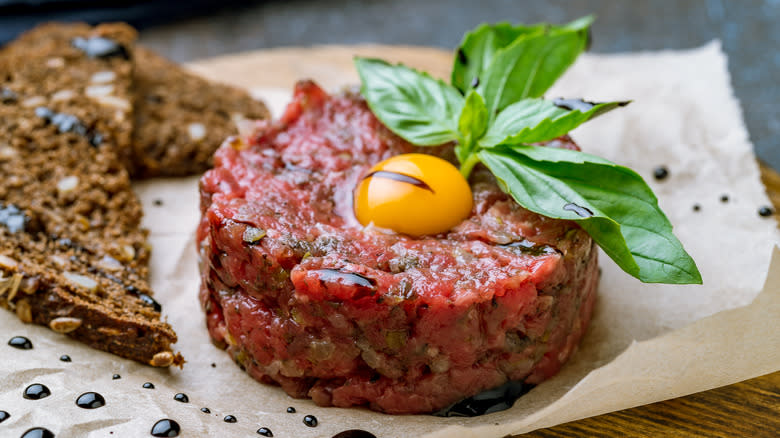
If asked to think of a dish that embodies the utmost sophistication, steak tartare might soon come to mind. With its rich flavors and indulgent texture, this raw delicacy has long been a popular pick on the menus of restaurants across the world. Steak tartare is typically made by chopping raw beef, seasoning it with some other ingredients such as capers, onions, and Dijon mustard, and shaping it into a circular patty. The final touch is usually a raw egg yolk served on top of the patty for extra richness.Yet mastering the art of crafting the ultimate steak tartare in your home kitchen is no simple feat. From the selection of the meat to the final presentation, it's a dish that certainly requires some culinary finesse. Every step demands precision and attention to detail, and even the most experienced of home cooks can fall victim to common errors that will result in a lackluster plateful.
Join us as we delve into the 12 prevalent mistakes that might hinder your steak tartare preparation. We'll explore how each aspect can contribute significantly to the dish's success or downfall, offering the solutions that will take your steak tartare game to new levels. Whether you're a novice cook looking to try something new or a seasoned enthusiast wanting to refine your technique, this guide will have you on your way to creating restaurant-quality steak tartare. So, let's learn how to perfect this timeless classic.
Read more: Cuts Of Steak, Ranked Worst To Best
Using Store-Bought Ground Beef
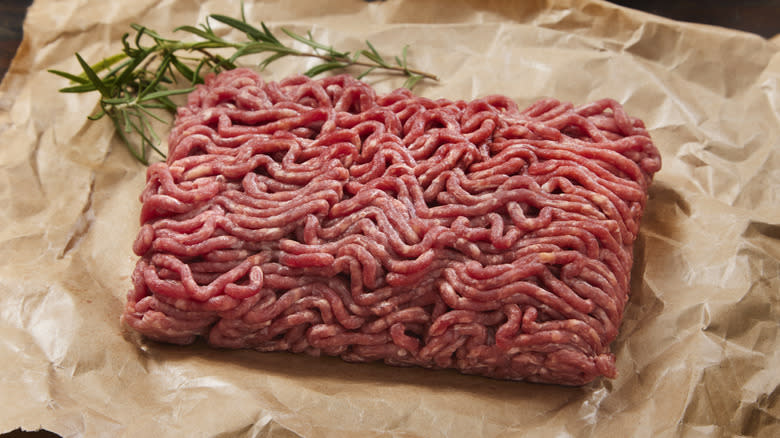
In the rush of modern life, convenience often beckons, and using pre-packaged ground beef for your steak tartare might seem like a time-saving solution. However, opting for a store-bought ground beef is a risk that's not worth taking with your steak tartare and likely will result in a mediocre final dish that's potentially unsafe for consumption.
Store-bought ground beef typically lacks the freshness and quality essential for this raw delicacy. Mass-produced and pre-packaged, it often contains a blend of various cuts with inconsistent fat content, compromising the texture and flavor profile of your tartare. Furthermore, the exposure to air and extended shelf life can result in oxidation, altering the taste and color of the meat. Consuming raw ground beef can also be dangerous. Due to its heavy processing, it can often harbor bacteria that is harmful to human health and therefore requires cooking to an internal temperature of at least 160 degrees Fahrenheit. If you ask us, it's not worth risking potential food poisoning just to save on prep time.
To practice good food safety and elevate your steak tartare from ordinary to extraordinary, embrace the artisanal approach. The best option is to select a premium cut of beef from a trusted butcher that can then be hand-cut into small, uniform pieces. This will ensure the your steak tartare is safe to eat. We assure you that the superior quality and freshness of the meat will shine through in every bite.
Selecting The Wrong Cut Of Meat
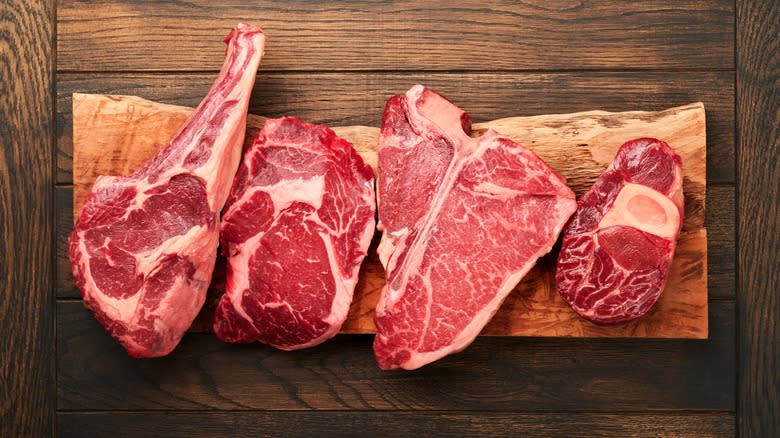
The foundation of exceptional steak tartare starts with selecting the right cut of meat. Choosing the wrong cut can spell disaster for your dish, completely throwing off the texture and flavor. When it comes to steak tartare, leaner cuts like filet mignon or tenderloin are the ideal choices. These cuts boast a more delicate, tender texture and a subtle flavor, perfect for showcasing the freshness and quality of the meat.
Opting for cuts with excessive marbling or fat content, such as ribeye or T-bone, can lead to an overly fatty or chewy tartare. Similarly, tougher cuts like flank or round steak are ill-suited for raw preparations as their fibrous texture requires cooking to tenderize the meat. If you must use a fattier cut, be sure to trim away as much of the excess fat and sinew as possible before chopping it up. Though if you want to achieve optimum tenderness and succulence in your steak tartare, it's best to choose the leanest option available.
Using Poor Quality Meat
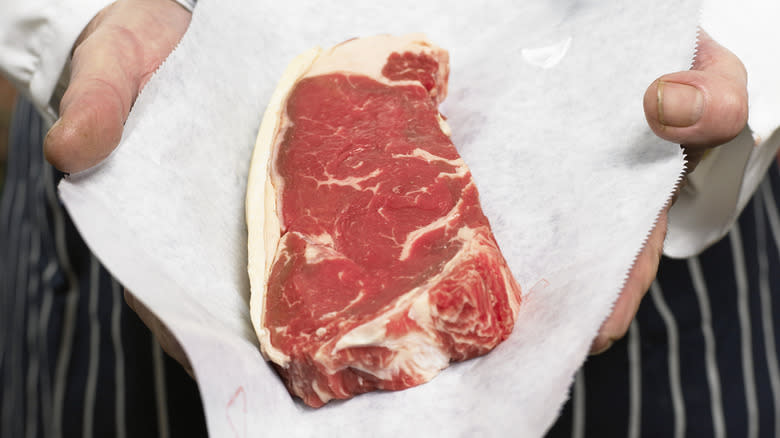
So you've chosen the right cut, but how do you ensure your meat is top quality? In the realm of steak tartare, using poor quality meat is a surefire way to sabotage your dish before it even hits the plate. Whether it's tough, flavorless, or lacking in freshness, subpar meat simply won't cut it when you're eating it raw.
When sourcing meat for your steak tartare, prioritize freshness and quality above all else. You'll need to make sure the beef you choose is suitable for consuming raw, so opt for cuts that are free from blemishes and that have a red or pink color and a clean, fresh aroma. Avoid meats that appear discolored or have an off-putting odor, as these are signs of spoilage. Additionally, consider the source of your meat. Choose cuts from reputable suppliers or trusted local butchers who will know exactly where the meat has been sourced from and can provide you with expert guidance on selecting the perfect meat for your tartare.
By investing in premium-quality meat, you'll set the stage for a successful steak tartare, so make sure to spend some time sourcing the finest meat you can get your hands on.
Not Cutting The Meat By Hand
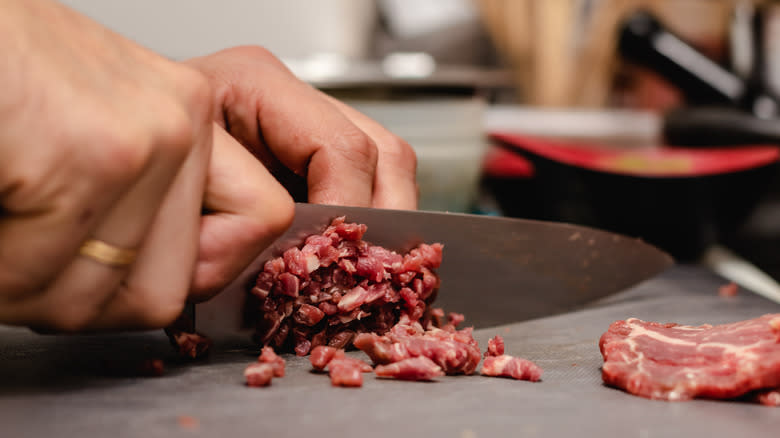
One of the cardinal sins when it comes to making steak tartare is not prepping the meat by hand. While it may seem efficient to use a food processor or meat grinder to chop the meat, the truth is that these methods often result in an inferior texture. In the words of the Online Culinary School, a food processor can "utterly destroy" a steak tartare.
Instead, an authentic steak tartare should have a delicate, hand-cut texture. By using a knife to finely chop the meat, you ensure a tender, melt-in-your-mouth consistency. Hand-cutting also allows you to control the size and shape of the meat pieces, resulting in a more consistent look. It's a far more rewarding experience overall, and that will give you a much greater sense of craftsmanship!
For the ultimate texture, the site Great British Chefs recommends first slicing the beef lengthways into very thin sections — about 1/5-inch thick. Next, slice these sections into strips of the same thickness before arranging the strips in a line and dicing them into small cubes. Then, they're ready to mix with the savory seasonings.
Chopping With The Wrong Kind Of Knife
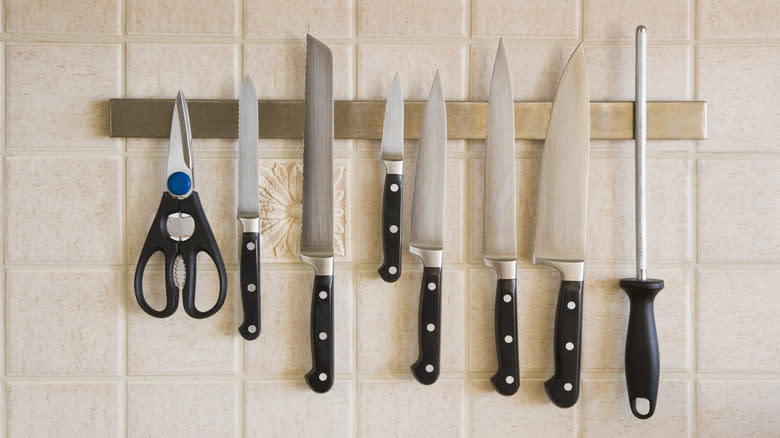
Believe it or not, the type of knife you use can significantly affect the quality of your steak tartare. Using the wrong kind of knife can result in uneven cuts and a tougher texture.
When it comes to chopping meat for tartare, a very sharp, non-serrated knife is essential. Avoid using serrated knives, as they can tear and shred the meat, resulting in a jagged and uneven texture. Instead, opt for a sharp chef's knife with a straight blade, which allows for clean, precise cuts. This will help you achieve a finer and more uniform texture in your steak tartare.
Ensure that your knife is properly sharpened before starting the chopping process. A sharp knife will glide through the meat with ease, not only making the task simpler but also causing less damage to the meat fibers. After you spend all that time and money selecting the best beef for your tartare, the last thing you want to do is ruin it with a blunt knife!
Not Adding Garnishes
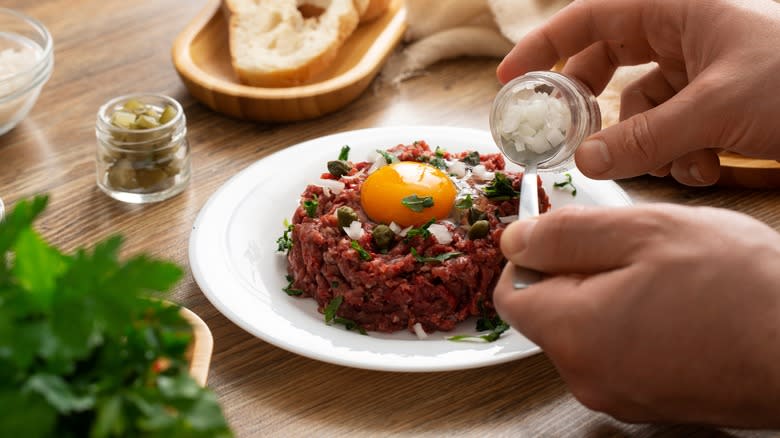
While focusing on proper selection and preparation of the meat itself is vital, you should also be sure you don't neglect the importance of adding garnishes to your steak tartare. Overlooking those tasty additions can result in a lackluster presentation and missed opportunities to enhance the flavors of the meat.
Your choice of garnishes can play a crucial role in bringing depth, texture, and aesthetic appeal to steak tartare. The dish is most commonly served topped with a vibrant fresh egg yolk, and the popularity of this addition is for good reason. The egg yolk brings a rich and creamy texture that perfectly balances with the delicate, tender beef. But there's plenty of room to get creative with other toppings and garnishes here! From the briny bite of capers to the tang of pickled onions, each addition to the plate contributes its own unique qualities. Fresh herbs like parsley or chives can also lend a burst of freshness, or you could even serve the steak tartare on a bed of fresh arugula leaves.
At Gordon Ramsay Restaurants, steak tartare reaches new levels of deliciousness with garnishes of gherkin gel, nasturtium leaves, bronze fennel, and gherkin slices, all alongside the classic egg yolk.
Not Making It Fresh And Serving Immediately
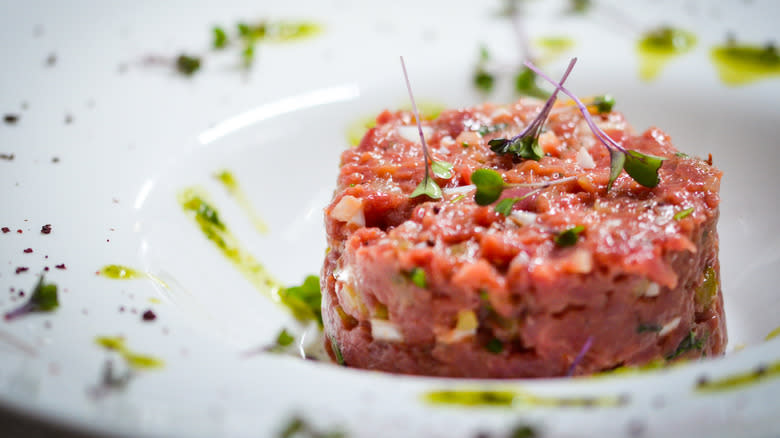
Steak tartare is a dish best enjoyed fresh and served immediately after preparation. A common mistake is failing to recognize the importance of timing in serving this raw delicacy.
Once the meat is chopped and seasoned, its flavors begin to meld and develop. However, prolonged exposure to air can cause oxidation, which alters the taste and texture of the tartare. Additionally, the longer the tartare sits at room temperature, the greater the risk of bacterial growth, which could make it unsafe to eat.
To ensure the ultimate freshness and flavor in your steak tartare, keep it chilled until right before chopping, and prepare the meat just before serving. This allows you to enjoy the meat at its peak, with all its natural juices and flavors intact. If you must prepare the tartare in advance, store it in the refrigerator for no more than a couple of hours before serving. Cover it tightly with plastic wrap to minimize exposure to air and prevent oxidation.
Not Chopping The Shallot Or Onion Finely Enough
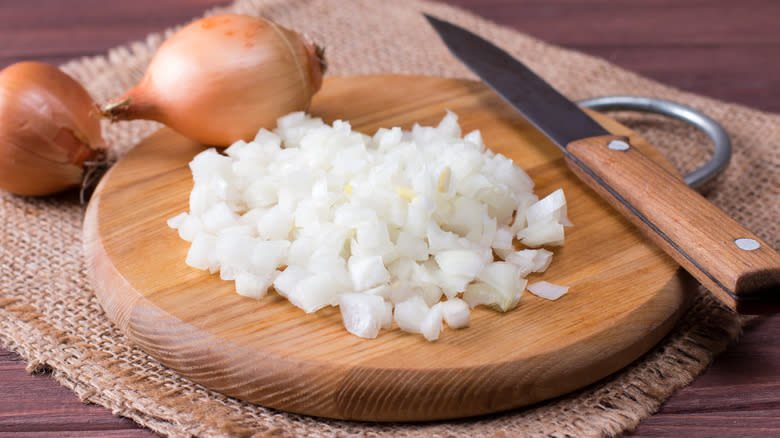
In the delicious combination of flavors that is steak tartare, every ingredient plays a crucial role. A common addition to the meat is the humble shallot. Onion is often used in its place too. However, when prepping either, it's essential to chop it very finely and into uniform pieces.
Chunky pieces of onion or shallot can overpower the delicate flavors of the meat or create an unwanted crunchy texture in the tartare. Unevenly chopped chunks can also result in inconsistent flavor distribution throughout the meat. When chopping, aim for pieces that are small enough to blend seamlessly with the meat, dispersing their flavor evenly throughout the dish.
First, grab a sharp knife and cut the shallot or onion in half lengthways. With the cut side facing down, make fine, vertical cuts while keeping the root intact. Then, slice horizontally at similar intervals. The last step is to cut vertically again, this time at a right angle to your original vertical cuts. The result will be beautifully uniform and finely chopped shallot or onion that will provide the perfect flavor and texture to your tartare.
Not Putting The Beef In The Freezer Before Chopping

A super handy hack that often gets missed when it comes to prepping steak tartare is briefly freezing the beef before chopping. Neglecting this step could potentially lead to mushy, overworked meat.
Giving the beef a short chill in the freezer before chopping serves multiple purposes. Firstly, it firms up the meat, making it much easier to handle and ensuring clean, precise cuts with your knife. This helps prevent the meat from becoming too soft or mushy as you chop it, meaning the final dish will have a far more desirable texture. Secondly, chilling the beef helps to partially freeze the exterior while keeping the interior raw, which therefore means working with and serving the beef at a lower temperature. This lowers the risk of bacterial growth during prep, making the meat safer to consume raw. By the time you're ready to tuck in to your steak tartare, it'll still be at a pleasant, chilled temperature that will also help to give you the ultimate flavor and texture experience.
To chill the beef, simply place it in the freezer on a tray or plate for 15-20 minutes, making sure not to freeze it completely. Once sufficiently chilled, remove the beef from the freezer and immediately proceed with the chopping process.
Skipping The Crostini
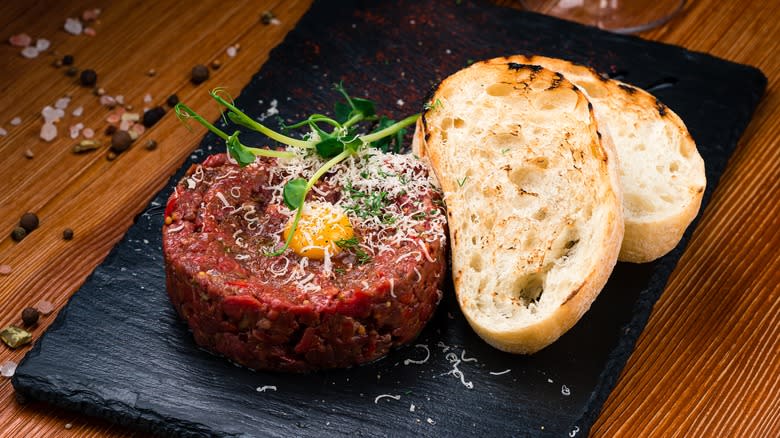
What better accompaniment to rich, tender meat is there than crisp slices of freshly toasted bread? In the rush to get to your delicious steak tartare, don't forget to add some crostini. It's a popular pairing with a plate of tartare, and leaving it out can deprive you of that wonderful textural contrast and a crunchy vehicle for enjoying the flavorful meat.
Crostini, or toasted bread slices, serve as the perfect canvas for the velvety texture of the tartare. Their crispness provides a satisfying crunch to every mouthful while also allowing you to scoop up and enjoy every morsel of tartare with ease. Their sturdy structure prevents the tartare from spilling or slipping off too, meaning a mess-free dining experience. To make crostini, simply cut a French baguette or your favorite fresh bread into thin slices, brush with a little oil, and toast them in the oven or under the broiler until golden brown and crispy. You can further enhance their flavor by rubbing them with a clove of garlic and sprinkling some flaky sea salt on top before toasting.
If you're not an avid bread-eater, steak tartare and fries is another popular combination, which can make for a more filling meal. Or, if you still want that crunch, you could opt for some crackers or even tortilla chips.
Under- Or Over-Dressing The Meat
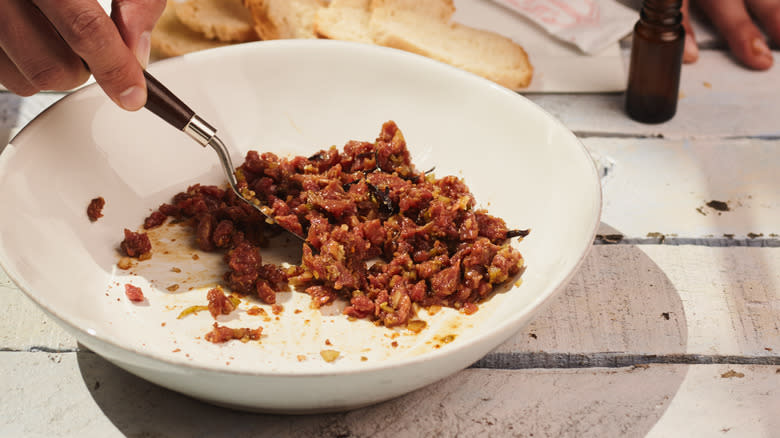
Finding the perfect balance of seasonings and dressings for your steak tartare can be tricky, and over- or under-doing it can result in a dish that falls short of its full potential. The additions to the chopped steak should enhance the natural flavors of the beef without overpowering them. Too little seasoning leaves the tartare bland and uninspired, while adding too much can mask the delicate taste of the meat and disrupt the texture.
A good method to follow is first seasoning the meat conservatively, then tasting as you go and adjusting to your preference. Common additions to the chopped meat include capers, shallot or onion, mustard (Dijon mustard is common), and various sauces. However, you might prefer to opt for a more unique twist on this classic dish. Chef Ignacio Mattos serves a version of steak tartare at his Michelin-star restaurant Estela in New York with elderberries and sunchokes. Michelin-star chef Christopher Kostow uses ember mayo, spring onions, and milk bread for the aged beef chuck tartare served at The Charter Oak, his restaurant in California.
Adding An Egg Yolk That Isn't Fresh Enough
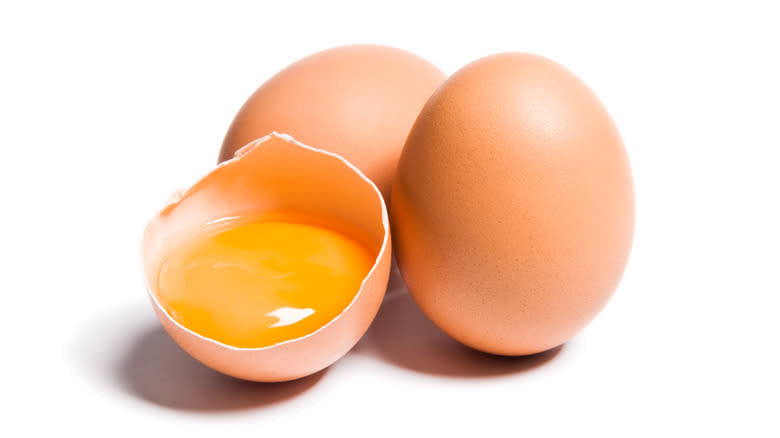
A key component of an excellent steak tartare is that sunny egg yolk that sits atop the delicious meat. But, just like the beef, it's vital to ensure you are using fresh, high-quality eggs that will deliver maximum flavor and be safe to consume raw. When it comes to choosing a yolk, the first decision is whether to opt for a classic chicken egg or perhaps something more unusual. Some recipes suggest using a duck or quail egg for extra richness, flavor, and, of course, added sophistication!
Whichever variety you choose, be sure to purchase it from a reputable supplier. Go for free-range and organic if you can, with a long expiration date, and keep them in the fridge until you're ready to use them. When selecting the perfect egg, you'll want to look for signs of peak freshness. First, check the shell to make sure there are no cracks or areas of discoloration. If it passes the test, crack the egg carefully, inspecting the yolk and white for any signs of spoilage. A fresh egg yolk should be vibrant yellow or orange in color with a clean, neutral aroma.
If you're unsure about the freshness of your eggs, err on the side of caution and discard any questionable ones. It's better to be safe than sorry when it comes to food safety, especially when consuming raw ingredients.
Read the original article on Mashed

